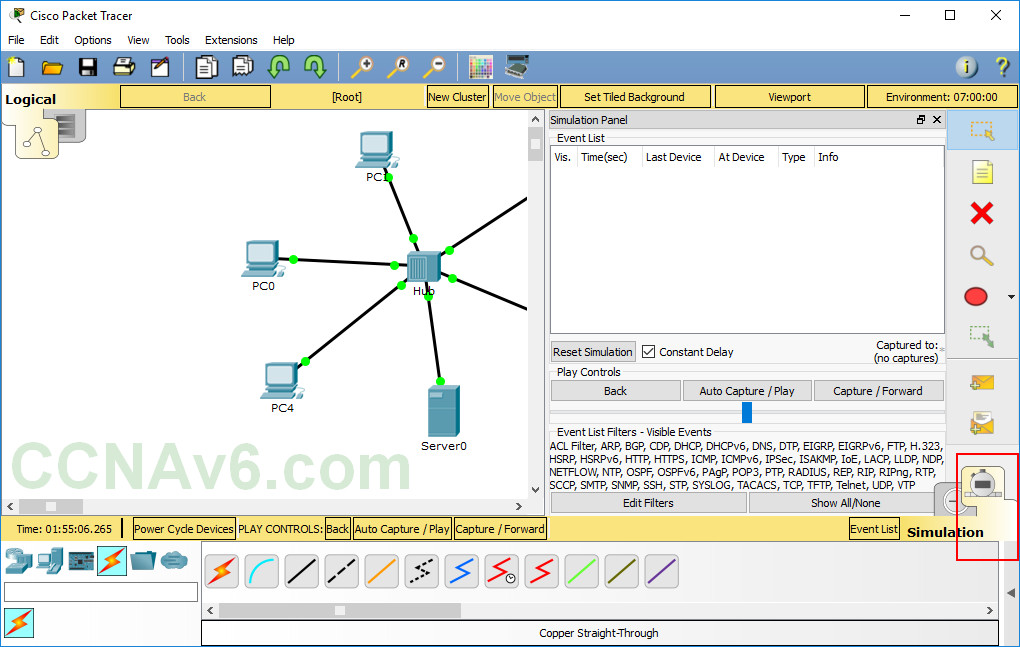

- #Basic cisco packet tracer tutorial how to#
- #Basic cisco packet tracer tutorial password#
- #Basic cisco packet tracer tutorial Pc#
- #Basic cisco packet tracer tutorial free#

The commands remain almost the same as for the router only that in a switch, we’ll use the IP address of its VLAN interface to access it from the PC. Here, we’ll configure SSH on a multi-layer switch. You can proceed and do configurations on the Router.You’re now managing the router remotely from the PC.Īt this point, let’s move on and configure SSH on a switch.
#Basic cisco packet tracer tutorial password#
Provide the enable password (the one you set in step 4) to access the privileged executive mode. You’re now probably in the CLI of the router. Provide the login password which you set in step 5 and press enter. On the command prompt of the PC, open a SSH session to the remote router by typing the command: ssh -l admin 10.0.0.1ĩ. Move on to see if you can access the router remotely from the PC.Ĩ. MyRouter(config-line)#transport input ssh myRouter(config)#ip ssh version 2ħ.Now connect to VTY lines of the Router and configure the SSH protocol. The password will have to be provided before you can access the CLI of the router when using SSH.Ħ.Specify the SSH version to use. myRouter(config)#username admin password admin ĥ.Set username and password for local login. Note that this password is not for use with SSH its only for use in accessing the privileged executive mode of the router after you are able to access its CLI remotely via SSH. % Generating 1024 bit RSA keys, keys will be non-exportable.Ĥ. Choosing a key modulus greater than 512 may take The name for the keys will be: myRouter.adminĬhoose the size of the key modulus in the range of 360 to 2048 for your Now generate encryption keys for securing the session using the command crypto key generate rsa. Set domain name myRouter(config)#ip domain name adminīoth the hostname and domain name will be used in the process of generating encryption keys.ģ. Set Router’s hostname Router(config)#hostname myRouterĢ. Now, to set up SSH on the router, you’ll need to:ġ.
#Basic cisco packet tracer tutorial Pc#
Then do these basic IP configurations on the PC and the router: Once the connection has been established, a network admin can execute commands on the remote device.Ĭonfiguring SSH on a router in Packet Tracerįor this tutorial, we’ll configure SSH on the router so that you as the admin can access and manage it remotely using an SSH client on the admin PC. The client machine (such as a PC) establishes a connection to a SSH server running on a remote device (such as a router).

SSH is a client-server protocol, with a SSH client and a SSH server. However, with SSH, all data transmitted over a network (including usernames and passwords) is encrypted and secure from eavesdropping. Secure Shell, just like Telnet, enables a user to access a remote device and manage it remotely.
#Basic cisco packet tracer tutorial how to#
And other studies show that students taking courses online score better on standardized tests.Welcome to this tutorial! Here, we’ll have an overview of Secure Shell ( SSH) protocol, then see how to configure it on a switch and a router in Packet Tracer. Students participating in online classes do the same or better than those in the traditional classroom setup.
#Basic cisco packet tracer tutorial free#
After all, you worked hard to complete all these courses in your free time, you owe it to yourself to make sure they count. Just make sure you do it thoughtfully so you're sending the right message about your continuing education.

Listing online classes on your resume is a definite do. That said, online education is only worth your time if you are earning accredited online degrees from accredited colleges. Tuition is usually lower and there are practically no travel costs involved. Cost is another benefit, as most online courses are much cheaper than a traditional classroom program.


 0 kommentar(er)
0 kommentar(er)
